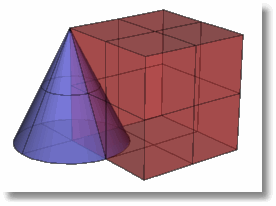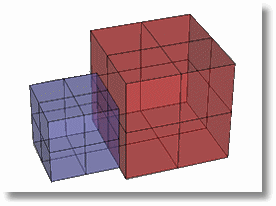![]()
Solid Tools > Boolean Difference
![]()
Solid > Difference
Notes:
Select either the first object or all the objects before starting the command.
Boolean commands can also be used with surfaces and open polysurfaces. The result depends on the direction of the normals of the object. Use the Dir command to see the direction. If the results are the opposite of what you want, reverse the direction of the surface with the Dir or Flip commands and try again.
Try the Join command first on surfaces.
For mesh objects see the Mesh Boolean commands.
Cuts away the shared areas of selected polysurfaces or surfaces with another set of polysurfaces or surfaces.
Steps:
Option
|
Solid Tools > Boolean Difference
Solid > Difference |
Cuts away the unshared areas of selected polysurfaces or surfaces.
Steps:
|
Solid Tools > Boolean Intersection
Solid > Intersection |
Cuts away the shared areas of selected polysurfaces or surfaces and creates a single polysurface from the unshared areas.
Steps:
|
Solid Tools > Boolean Union Main2 > Boolean Union
Solid > Union |
Cuts away shared areas of selected polysurfaces or surfaces and creates separate polysurfaces from the shared and unshared parts.
Steps:
Select the cutting objects and press Enter.
Note: The cutting objects and the objects to split can be the same objects.
|
Solid Tools > Boolean Split
Solid > Boolean Split |
Enables iterating through Boolean operations (Union, Intersection, Difference A_Minus_B and B_Minus_A, and Inverse) with mouse click.
Steps:
Select two objects.
Click the mouse in the viewport until you get the object you want.
Option
|
Solid Tools > Boolean 2 Objects (Right click)
Solid > Boolean Two Objects |
The steps are the same as for the NURBS Boolean equivalent.
Note: The result of a command is always a mesh regardless of the input object type.
Cuts away the shared areas of selected meshes, polysurfaces, or surfaces with another set of meshes, polysurfaces, or surfaces.
|
Mesh Booleans > Mesh Boolean Difference
Mesh > Mesh Boolean > Difference |
Cuts away the unshared areas of selected meshes, polysurfaces, or surfaces.
|
Mesh Booleans > Mesh Boolean Intersection
Mesh > Mesh Boolean > Intersection |
Cuts away the shared areas of selected meshes, polysurfaces, or surfaces and creates a single mesh from the unshared areas.
|
Mesh > Mesh Boolean Union Mesh Booleans > Mesh Boolean Union
Mesh > Mesh Boolean > Union |
Cuts away shared areas of selected meshes, polysurfaces, or surfaces and creates separate meshes from the shared and unshared parts.
|
Mesh Booleans > Mesh Boolean Split
Mesh > Mesh Boolean > Boolean Split |
Troubleshoot Boolean Operations
Boolean operations can fail for a number of reasons:
Normals may not point the way you expect.
Control points tend to stack up at the intersection of the two objects.
Objects may have overlapping surface areas.
The Boolean operations use the surface normal to determine which pars to keep and which to throw away. When you attempt a Boolean Difference and you get a Union instead, or vice versa, this is because the objects have normals that are the opposite of what you expect.
Boolean operations tend not to work well if the objects have overlapping surface areas, or only touch each other at a particular location or along edges. For success using the Boolean operations, the objects should push all the way through one another and not be tangent.
Coincident control points occur when the control points at the edge of a surface are at an identical location. This occurs in Rhino naturally at the tip of a cone or the pole of a sphere or a three-sided plane. You can also move control points to the same location. This point is also called a singularity.
When a singularity point occurs at the intersection of two objects you want to Boolean, the operation can fail.

Overlapping surface areas occur when two surfaces share the same area. In this example, the two boxes are just touching along one side. The objects will Union, but Difference, and Intersection will not work.

If your objects won't Boolean, you can use other techniques to get the results you want.
In this example, the apex of the cone is exactly at the corner of the box. This is one of the situations that can cause the Boolean operations to fail.
Instead of using Boolean operations in this case, use the Explode command to separate polysurfaces into single surfaces if necessary. Use the Intersect command to create curves that represent the intersection of the two surfaces. To create the parts, use these curves to Trim and/or Split and then Join them back together.